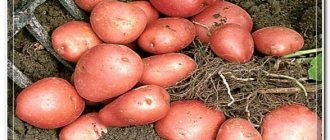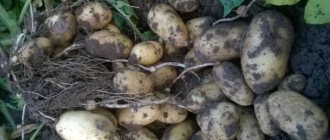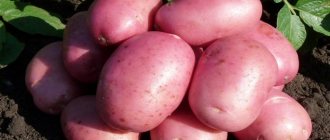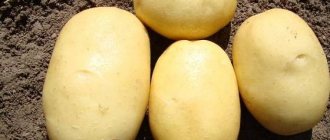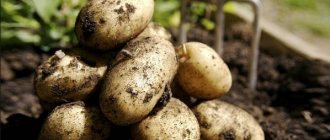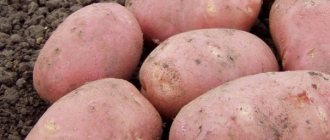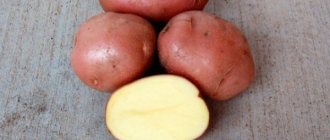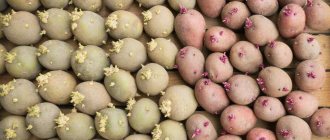Breeze potato planting dates
This potato variety is planted, like all others, when the soil warms up to 10 degrees. This usually happens at the end of April-May. You can plant it earlier, but potatoes will sprout only in warm soil.
Some gardeners advise germinating potatoes before planting, then they will take root in the ground faster. To sprout potatoes, 20 days before planting, lay them out in a warm room and spray them with water, turning them over occasionally.
Plant Breeze potatoes in pre-prepared holes. It is recommended to dig up the soil in the fall and apply fertilizer. But if this was not done in the fall, you can apply fertilizer to each hole in the spring immediately before planting.
Potatoes are planted at a depth of 10 cm, the distance between holes is 30 cm, and between rows 70.
Step-by-step instructions for growing
Potatoes are planted after such predecessors as crops:
- pumpkin;
- cabbage;
- legumes
The ridges are directed from north to south.
Inventory
To plant and cultivate Breeze potatoes, you will need the following equipment:
- Pitchfork.
- Harrow.
- Flat cutter.
- Motoblock.
The equipment is treated with a solution of copper sulfate.
Preparation
Includes several stages:
- site preparation;
- sorting and processing of seeds.
Soils
In autumn, fall plowing is carried out to a depth of 15 cm or peeling.
The following is added to the ground per 100 m²:
- manure 2-2.5 c;
- phosphorus-potassium mixture 2-2.5 kg;
- composts up to 3 c.
When sowing, add 1 tbsp to the planting holes. ash and a handful of peat.
Tubers
2-3 weeks before planting - from mid-April, the tubers are germinated in the light. Select large and whole specimens. To do this they:
- Place in boxes in 1-2 layers with low walls.
- Maintain a temperature of 13 degrees, humidity 60-70%.
Planting material is ready for planting when the shoots reach 1-1.5 cm.
For disinfection, soak in a solution:
- 1% potassium permanganate;
- 1% Fitosporin;
- formaldehyde.
The following fungicides are used for preventive treatment:
- Agat-25;
- Planriz.
To strengthen sprouts and future shoots, dust the potatoes with ash.
The following germination options are also used:
- Humid environment. The tubers are placed in bags, a mixture of soil and peat, sawdust or sand, for up to 3 weeks.
- Drying. Spread the potatoes indoors to a layer thickness of up to 10 cm. Keep for 10 days. The method activates the awakening of sprouts.
Boarding time
They begin planting tubers in early May, when the surface of the earth and a depth of 10-12 cm warms up to 8-10 degrees.
The air temperature at night should not fall below 12-14 degrees. Planting lasts until mid-May.
Scheme
They adhere to certain parameters when planting tubers in a stationary place:
- The gaps between holes are 40 cm.
- The distance between rows is 65-70 cm.
- The depth of the holes is 10-12 cm with classic planting.
It is not advisable to thicken the bushes. When plants have enough light and nutrition, productivity is much higher.
Care
As the potatoes grow, they are loosened, hilled, watered, and mulched. Proper care improves the formation of additional stolons with tubers.
Hilling
The depth of hilling depends on the type of soil:
- On light, loose sand, 14-15 cm.
- On heavy loams and clayey soils 8-11 cm.
The procedure is carried out 2-3 times during the summer:
| Stages | When they spud | Notes |
| First | Shoot height 15-20 cm | |
| Second | When buds appear | The day before they feed with complex formulations:
|
| Subsequent | After 2 weeks, until the tops close |
Watering
Water no earlier than a month after planting.
Check the humidity before forming buds at a depth of 12-15 cm; if the soil is dry, proceed with watering. From the flowering stage, potatoes require more water. Subtleties of watering:
- Repeat once every 10 days in the absence of rain.
- If there is precipitation, water less often.
- Water is poured so as to saturate the ground to 20 cm.
- Use sprinkler systems or water in furrows.
- If the soil sticks to the hoe, it is too early to water.
Potatoes love moderately moist, loose soil with the possibility of aeration. Excess moisture leads to late blight, rot, and black leg.
20-24 days before the start of harvesting, watering is stopped.
Loosening
If the surface is not mulched with straw, loosening will be required. The first time they loosen shallowly - 5-6 cm in thickness.
Loosening is carried out before the emergence of shoots - a week after planting, a flat cutter or harrow is used. The procedure increases aeration, prevents the appearance of crusts and the germination of weeds. It should be harrowed 2 times before germination.
Simultaneously with hilling, the row spacing is loosened. In large areas they use a walk-behind tractor. When compacting, the surfaces are loosened to a depth of 8-10 cm. Each watering is completed by loosening.
Weeding
It is carried out in small areas manually, in large areas using a weeding machine. At the same time, inspect the bushes for the presence of aphids and visible damage from infection. In the absence of mulch, weeding is carried out every 2 weeks.
Top dressing
Over the entire season, 3 root and foliar feedings will be required.
Fertilizers use organic matter - manure, green manure. After using organic fertilizers, productivity increases by 2 times. Ash - bring in for digging, pour 1 tbsp into the holes. when planting, further consumption is 5 kg per 1 hundred square meters.
Fertilizers should be rich in nitrogen, potassium, phosphorus, iron, magnesium.
From mineral and complex compositions it is recommended:
| Name | Dosage per 1 hundred square meters |
| Ammonium nitrate | 1 kg |
| Potassium sulfate | 1.5-2 kg |
| Superphosphate | 1 kg |
| Nitrophoska | 5 kg |
| Urea | 1 kg |
Productivity of the variety
The Breeze potato variety is considered high-yielding. On average, they take 300 kilograms per hundred square meters. The largest harvest was harvested in the homeland of this variety - in Belarus.
The harvest largely depends on feeding and caring for potatoes. Also depends on the region where it is grown. So in the southern regions they harvest two crops per season.
On average, 12 potatoes are dug out from under each bush.
For better fruiting, it is recommended to feed potatoes several times a season: when the sprouts rise by 10 cm, during the appearance of buds and during flowering. For this, superphosphate, sulfate and urea are used.
Organic fertilizers are very suitable: bird droppings, mullein solution. We recommend an article about fertilizing potatoes.
It is recommended to combine hilling with the fertilization process. It is also important to maintain a watering schedule, especially in dry soils. How to do this correctly, we read in the article - Why hill up potatoes.
Advantages and disadvantages
The variety has become widely known thanks to an impressive list of advantages:
- When assessing the taste characteristics, cooks give potatoes 7 points on a scale of 10.
- The crop shows good yield in the absence of intensive fertilizing and regular watering.
- Potato skins are easy to peel.
- The tubers can be consumed until a dense skin is formed; after its formation, they can be sent for long-term storage.
- The plant is not affected by cancer, nematodes, and several types of mosaics.
- A starch content of 14–16% ensures wide use in cooking, since root vegetables do not crumble during cooking, but are well kneaded when making purees.
The disadvantages include:
- low resistance to late blight;
- tendency to reduce the mass of tubers when constantly using one’s own crop for planting.
Disease resistance
Basically, this Breeze variety is resistant to various diseases, except golden nematode, scab and late blight.
Signs of late blight on potatoes.
Late blight appears as dark spots on the stems and leaves of the plant. To catch the development of the disease at an early stage and prevent its further development, periodically inspect the potato tops. If the first signs of the disease appear, spray the diseased plant with fungicides or garlic solution.
Also, fungicides such as Aquaflo and Fungazil 100 SL help well in the fight against scab. The most complex disease and almost invisible is the nematode - these small worms lay larvae in potato tubers, which completely stops its development.
To combat them, it is proposed to use chemicals containing heterophos or urea.
Insect pests – Colorado potato beetles and wireworms – also pose a separate problem for him. To combat beetles, you can also spray potatoes with special preparations. And a manganese solution helps well against wireworms. How to remove wireworms from potatoes, read here.
Reviews of the Breeze potato from those who planted
Veronica, Taganrog
The potatoes are good, tasty, and don’t fall apart. Stored well. Only closer to spring it is necessary to sort through. But overall not bad. We like.
Valery, Sosnovy Bor
I have been planting for four years now. Everything is fine. Fruits well. But I feed him according to the rules. And we hill up and loosen. Maybe if they didn’t do this, the result would be bad. It fits well too. It tastes good too. Good variety. I recommend it.
Alexey, Naro-Fominsk
I don't know much about the taste of potatoes. Potatoes are like potatoes. And everyone has their own taste. It produces a good harvest. Although I don't take much care of him. I hill up twice in total, and often water only when there is a drought. I spray it a couple more times for pests and that’s it. We can say that it is an unpretentious variety.
Vitaly, Moscow
I am planting potatoes to sell. I harvest it using technology, after which the potatoes still have a marketable appearance and do not spoil. Stored well. It also handles the road well, but I don’t drive far. If they buy it normally, it means it’s delicious.
